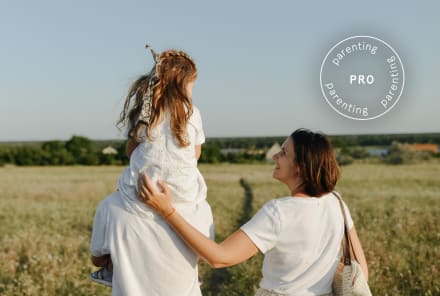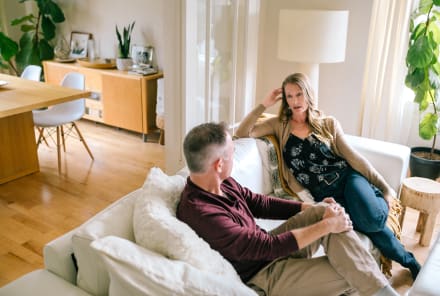Advertisement
Can Your Attachment Style Change? A Therapist Explains

Attachment style is a topic that is finally getting some much-needed attention. Why? Because everything we do derives from our attachment with others. How we manage romantic relationships, how we relate to our co-workers, and even how we parent comes from our own attachment style.
According to attachment theory, adults typically have one of four attachment styles: secure, anxious, avoidant, or fearful avoidant. Most people know your attachment style is built in childhood and typically maintained throughout your life, and the goal is always to be securely attached. That means you're able to form secure relationships with others, can trust easily, and are able to love and be loved. A person with a secure attachment style isn't afraid of intimacy or fearful of others leaving when space is given.
But research suggests only 56% of adults have a secure attachment style. So what happens when you have an insecure attachment style—that is, you tend to be more avoidant or anxious? Can you ever get to secure attachment if your childhood set you down a path of insecurity?
More simply put: Can your attachment style change? The answer is yes, and here's why:
How your attachment style can change throughout your life.
Three distinct scenarios come to mind when we talk about changing one's attachment style.
Scenario 1: Through life experiences.
A boy—let's name him Aaron—grows up in a loving home. His parents take great care of him, no noticeable trauma was present throughout his upbringing, and he learned very early how loved he was. His parents' consistency showed him that he can trust others while learning to love and be loved. He grew up with a secure attachment style.
Later in life when he began to date, Aaron experienced a series of unhealthy romantic relationships involving partners that did everything from cheating to lying to monitoring his phone and social media. These partners had one of the insecure attachment styles, and it wreaked havoc on him.
Instead of allowing the secure attachment style that he has always known to stay strong and firm, Aaron allowed a wall to build up. He began to become avoidant and dependent upon himself. He was trying so hard to protect himself from getting hurt again by the next relationship that he became the opposite of what he needed. His attachment style moved from secure to avoidant.
Scenario 2: Between relationships.
I once worked with a client who we'll call Susan (she gave me permission to share her story) who had an anxious attachment style. She was in a relationship with someone where she was always on edge. It was not the healthiest relationship to begin with: She consistently found herself consumed with fears about whether he would leave her or whether he was talking to other women, dissecting all his words to create stories of why he may break up with her soon, and she felt extremely insecure when away from him. Susan even looked through his phone at some of his text message exchanges. No surprise to her, the relationship ended for multiple reasons.
After processing the breakup and doing some intense work in therapy, she met someone new. I immediately noticed a shift. The way she interacted and talked about him was completely different from the previous relationship. There wasn't a hint of jealousy or anxiousness. She was OK with the distance and any space he needed for work. They took amazing trips together, and she was able to love and be loved freely.
When I brought this to her attention, she acknowledged how true it was—the way she engaged with her new boyfriend was indeed much healthier than in her past relationship. Susan did not exhibit the anxiety and worry she had once felt. Later, we found out he also had a secure attachment style, which perhaps contributed to the noticeable difference in dynamic.
It was a prime example of a truth about the nature of attachment styles: A person's attachment style can change depending on who they are in a relationship with—or in some cases, permanently change.
Scenario 3: Through personal growth.
I have been aware my whole life that I have an anxious attachment style. This attachment style came from my upbringing (it's a long story!), and it affected the way I was showing up in my romantic relationships. I tended to need constant validation, I got nervous when my partner needed space, I questioned myself, I did not trust fully, and I had a hard time receiving love easily.
All that said, I have been in therapy on and off for over a decade. During this decade, I have done some deep work on myself and how I interact with others.
More recently, I was dating someone who clearly had an avoidant attachment style. I could not see it at first, but then the signs became clear. Instead of me going back into my normal anxious attachment style, I did the opposite. I started to exemplify elements of being securely attached. Seriously, my therapist literally stated, "I am so proud of you. I do not know if you see it, but lately you have been handling your relationships in a secured way!"
Bingo! It happened again—but this time, with me.
Why? I had put in the necessary work toward reaching a healthier state, and, man, did it feel good. To be honest, it still takes massive work on my end. I want to go back to my old "anxious" ways all the time because that is all I knew for so long. But it feels good to be on this side. Here is where I choose to stay!
Choosing to change.
Is it possible that Aaron, Susan, and I all had our attachment style change? I believe so.
Changing your attachment style for the better is no easy feat. It takes acknowledgment, work, rewiring of interactions, resetting boundaries, learning healthier ways of relating, and sorting through your trauma. Professional help usually goes a long way.
Here are some things to remember when working to change your attachment style:
- Know your attachment style and identify the styles of those around you. Trust me: It will help you tremendously in understanding the actions of others, and you will have more empathy and compassion.
- Acknowledge the process. A secure attachment style is the goal, but understand it may take time to get there. Give yourself grace if you are anxious, avoidant, or fearful avoidant. There is no time limit. Take your time to get to your desired destination.
- Don't go on this journey alone. Seek out a therapist or counselor if you have the means, or look to resources like books and podcasts for self-education.
No matter which attachment style you currently have, just remember we all are humans dealing with the same issues in different forms. You can truly do anything you put your mind to. If developing a healthier attachment style is one of your goals, you can do it!
Watch Next
Enjoy some of our favorite clips from classes
Enjoy some of our favorite clips from classes
What Is Meditation?
Mindfulness/Spirituality | Light Watkins
Box Breathing
Mindfulness/Spirituality | Gwen Dittmar
What Breathwork Can Address
Mindfulness/Spirituality | Gwen Dittmar
The 8 Limbs of Yoga - What is Asana?
Yoga | Caley Alyssa
Two Standing Postures to Open Up Tight Hips
Yoga | Caley Alyssa
How Plants Can Optimize Athletic Performance
Nutrition | Rich Roll
What to Eat Before a Workout
Nutrition | Rich Roll
How Ayurveda Helps Us Navigate Modern Life
Nutrition | Sahara Rose
Messages About Love & Relationships
Love & Relationships | Esther Perel
Love Languages
Love & Relationships | Esther Perel











